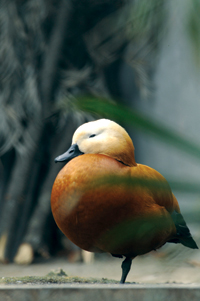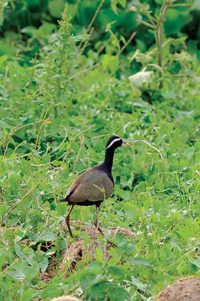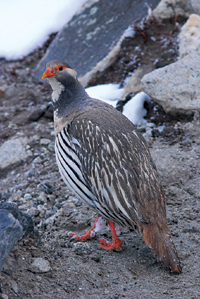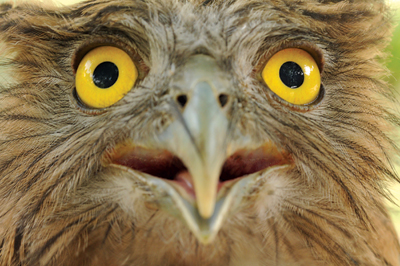With over 850 species of birds calling Nepal house at different times of the year, birding in Nepal is a pleasure.

Falcated Duck
In the early 1820s, when Brian Hodgson was living in Kathmandu as the Resident appointed by the British East India Company, Nepal was still cloaked in mystery. Hodgson was one of the few foreigners to whom Nepal had opened her doors. In return, Hodgson revealed Nepal to the outside world. Hodgson’s most valuable contributions to Nepal, besides other fields, were in ornithology. Although, like all foreigners, he was forbidden from venturing beyond the Kathmandu Valley, Hodgson was able to collect bird specimens by sending out local hunters beyond the valley for collection. In this way, he amassed almost 9000 bird specimens during his 22-year stay in Kathmandu. When he finally left Nepal with his massive collection of birds, and subsequently wrote of his discoveries, he aroused the interests of naturalists the world over. It had become clear that Nepal was an ornithologist’s paradise, where numerous species occurred that were still unknown to science.
Although Kathmandu only retains traces of the days when Hodgson lived here, some of the places where he collected his specimens have remained relatively pristine. Birds first discovered by Hodgson still inhabit pockets of forests left within and in the vicinity of Kathmandu. A single day’s birdwatching in and around Kathmandu is certain to yield a variety of bird species.
The Phulchoki forest in Kathmandu’s Southeast is one of the richest areas in terms of birds. The Godavari Botanical Gardens at the hill’s base is a good place to start one’s bird watching. Species like the Wedge-tailed Green Pigeon, Grey-chinned Minivet, Orange-bellied Leafbird, Grey-throated Babbler, numerous species of Laughing-thrushes, Black-throated Sunbird, Eurasian and Lanceolated Jays, Red-billed Blue Magpie, Rufous-throated Hill Partridge, Black-throated Parrotbill, Hodgson’s Redstart, Slaty-backed Flycatcher, and Yellow-bellied Flowerpecker are found in the garden. It is also home to the Spiny Babbler, Nepal’s sole endemic bird.

Bronze-winged Jacuna
Bird sightings increase with altitude in the Phulchoki hill. A total 288 species have been recorded from Phulchoki, a reflection of its richness in birdlife and importance as a habitat. The forest is especially important for two restricted-range species: the Spiny Babbler and the Hoary-throated Barwing. Some of the resident species of Phulchoki include Besra, Black Eagle, Mountain Hawk-Eagle, Kalij Pheasant, Common Hill Partridge, Ashy Woodpigeon, Mountain Scops Owl, Collared Owl, Golden-throated Barbet, Crimson-breasted Pied and Rufous-bellied Pied Woodpeckers, Spotted Forktail, Chestnut-headed and Grey-bellied Tesias, Chestnut-crowned and Black-faced Warblers, Lesser Scaly-breasted Wren-Babbler, Streak-breasted Scimitar-Babbler, Cutia, Nepal Fulvetta, and Brown-throated Treecreeper. Other species, like the Barred Cuckoo-Dove, Bay Woodpecker, Blue-naped Pitta, Pygmy Blue Flycatcher and Red-tailed Minla, are scarce and it is unclear whether or not they are residents. Speckled Woodpigeon, Golden Bush-Robin, Plain-backed and Long-tailed Mountain Thrushes, Greater Scaly-breasted Wren-Babbler, Fire-tailed Sunbird and Pink-browed Rosefinch are seen during the winter. The forest sees summer visits from the Crested Serpent Eagle, Lesser Cuckoo, Blue-bearded Bee-eater, Asian Sooty, Ultramarine, Little Pied and Snowy-browed Flycatchers, and Blue-capped Rock-Thrush.
There is more birding in Shivapuri, in the valley’s north. Although designated as a national park only in 2003, Shivapuri has had more protection from human encroachment historically than most other forests of Kathmandu. It was first set aside, albeit partially, as a protected area in 1975 under the Shivapuri Watershed Development Board. This early attempt to protect it has helped maintain 50 percent of its forest cover.
Shivapuri National Park is home to 178 species of birds, including significant numbers of the Spiny Babbler and Hoary Barwing. Other resident species of the park are the Speckled Piculet, Rufous-bellied Niltava, White-browed and Green Shrike-Babblers, Blue-winged and Red-tailed Minlas, Yellow-browed Tit and Brown Bullfinch. Grey-bellied Plaintive and Lesser Cuckoos, Jungle Nightjar, White-throated Needletail, Indian Blue Robin, Tickell’s Thrush and Yellow-bellied Bush Warbler are common during the summer. In winter, visitors to the park can see species such as the Northern Goshawk, Maroon-backed Accentor, White-tailed Rubythroat, and Scarlet and Gold-naped Finches. This ease of viewing had Carol Inskipp, a prominent ornithologist and authority on Nepali birds comment that Shivapuri’s lower slopes are one of the easiest places to spot the Spiny Babbler.

Rufous-throated Hill Partridge
Another must-go birding destination is Nagarjun - an extension of Shivapuri National Park. Formerly a playground for hunting-happy former Nepali royalty, the area has remained largely unaffected by the city’s growth. Besides the species found in Phulchoki and Shivapuri, rarer species like the Northern Eagle Owl and Forest Eagle Owl have been sighted here. Gokarna forest in the valley’s east is ideal for those with a penchant for viewing owls. Brown Fish and Brown Wood Owls are two resident species of owls here.
Terai’s Bounty
How can I see the maximum number of birds in Nepal? All bird enthusiasts that come to Nepal are sure to ask themselves this. Kathmandu offers numerous birds, but most of them are forest-dwelling species. If bird watchers wish to see as many of Nepal’s total 865 species as possible, they must travel out of Kathmandu. Chitwan National Park is the ideal place to begin this quest. The country’s oldest national park is located 120 kilometers south-west of Kathmandu in the country’s lowlands, known as the Terai. The park holds an incredible 540 species of birds—more than half of Nepal’s total figure.
This richness of avifauna is a result of the diversity of habitats found in Chitwan; hardwood Sal forests, riverine forests, grasslands, and a number of lakes comprise its total area of 932 sq. km. Due to this diversity of habitats, Chitwan is a refuge for Nepal’s birds; nearly two-thirds of Nepal’s globally threatened species are found here. It also holds healthy populations of grassland birds such as the Bengal Florican, Grey-crowned Prinia, Slender-billed Babbler and Lesser Adjutant. It is the only place in Nepal where the Slender-billed Babbler has been recorded and it’s speculated that it might hold the largest population of the species in the entire sub-continent. Chitwan is also the only place where the Grey-crowned Prinia is common. It is also one of the few places in Nepal, where the globally threatened Indian Spotted Eagle has bred. Chitwan is apparently a favorite amongst the birds of Nepal, especially those whose existence is at risk. Out of 22 of Nepal’s near-threatened birds, 15 are found in Chitwan.
The primeval-looking Great Hornbill and the Sarus Crane, which is one of the world’s tallest birds, can be seen in Chitwan. Other globally threatened species found in Chitwan include Swamp Francolin, Ferruginous Pochard, Bengal Florican, Lesser Florican, Black-bellied Tern, Indian Skimmer, Pallas’s Fish Eagle, White-tailed Eagle, Grey-headed Fish Eagle, Lesser Fish Eagle, White-rumped Vulture, Slender-billed Vulture, Cinereous Vulture, Red-headed Vulture, Pallid Harrier, Indian Spotted Eagle, Greater Spotted Eagle, Imperial Eagle, Lesser Kestrel, Laggar Falcon, Darter, Painted Stork, Black-necked Stork, Lesser Adjutant, Greater Adjutant, Kashmir Flycatcher, Hodgson’s Bushchat, Bristled Grassbird, Rufous-rumped Grassbird, Jerdon’s Babbler and Yellow-breasted Bunting.
 The birds of Chitwan can be divided into three categories on the basis of their habitats: those who live in forest, those that are found in grasslands, and those that spend most of their time in or near rivers. This not only gives a birdwatcher numerous choices but also presents an opportunity to combine birdwatching with other activities such as jungle walks, elephant rides, and canoe rides for viewing jungle species, grassland species, and wetland species respectively. During a walk along the park’s three rivers, one might come across species like Black-necked Stork, Bar-headed Goose, Great Stone-Plover, Little Pratincole, River Plover, Great Black-headed and Brown-headed Gulls, River Tern, Sandlark, Rosy Pipit, Temminck’s Stint and Kentish Plover. Wetlands such as marshes and lakes are frequented by Little Cormorant, Darter, Cinnamon Bittern, Black-crowned Night and Purple Herons, Asian Openbill, Wolly-necked Stork, Lesser Whistling Duck, Cotton Pygmy Goose, Purple Gallinule and Bronze-winged Jacuna.
The birds of Chitwan can be divided into three categories on the basis of their habitats: those who live in forest, those that are found in grasslands, and those that spend most of their time in or near rivers. This not only gives a birdwatcher numerous choices but also presents an opportunity to combine birdwatching with other activities such as jungle walks, elephant rides, and canoe rides for viewing jungle species, grassland species, and wetland species respectively. During a walk along the park’s three rivers, one might come across species like Black-necked Stork, Bar-headed Goose, Great Stone-Plover, Little Pratincole, River Plover, Great Black-headed and Brown-headed Gulls, River Tern, Sandlark, Rosy Pipit, Temminck’s Stint and Kentish Plover. Wetlands such as marshes and lakes are frequented by Little Cormorant, Darter, Cinnamon Bittern, Black-crowned Night and Purple Herons, Asian Openbill, Wolly-necked Stork, Lesser Whistling Duck, Cotton Pygmy Goose, Purple Gallinule and Bronze-winged Jacuna.
Sharp eyes and a good pair of binoculars are needed in the forests inhabited by Brown Fish Owl, Changeable Hawk-Eagle, Kalij Pheasant, Emerald Dove, Orange-breasted Green and Pompadour Green Pigeons, Moustached Parakeet, Oriental Pied Hornbill, Large Woodshrike, Black-naped Monarch, Puff-throated Babbler, Streaked Spiderhunter, Rufous-bellied Eagle, Forest Eagle and Tawny Fish Owls, Red-headed Trogon, Slaty Woodpecker and Little Spiderhunter.
Grassland species are elusive and difficult to spot. Some birdwatchers spend days just to see some of the species found in Chitwan’s large grasslands. Those that are fortunate may see the Pied Harrier, Striped, Yellow-legged and Barred Buttonquails, Bengal Florican, White-tailed Stonechat, Large and Bristled Grass Warblers, Black-breasted Weaver and Red Avadavat. With exceptional luck, one may get a glimpse of the Grass Owl.
 The Great Congregations
The Great Congregations
The aforementioned sites are known for their diversity of bird species. However, if you are keen on combining variety with quantity, then Koshi Tappu Wildlife Reserve and the Koshi Barrage area are the more important destinations. The total number of bird species recorded from Koshi Tappu is 485 and it is this huge number that has earned it a special place amidst Nepal’s birdwatching sites. The total bird count for a single day in February of 2003 was 9,800.
Koshi Tappu, the largest wetland in Nepal, is an important site for migratory birds. Every year it serves as the staging point for several species of migrating waterfowl and waders. It is considered one of the best wetlands for birds not only in Nepal but also for birds from all over Asia. Its value as a habitat is evident from the fact that it holds the largest heronry in Nepal, with nearly 26,000 nests being recorded.
/>There is a high presence of globally threatened birds in Koshi Tappu and Koshi Barrage area; twenty of them have been recorded from here. The habitat in the area is congenial for a number of wetland and grassland species such as Baer’s Pochard, Pallas’s Fish Eagle, Greater-Spotted Eagle, Imperial Eagle, Lesser Adjutant and Spot-billed Pelican. The area also has the highest number of Swamp Francolin, a globally threatened species, in Nepal. Another rare species, the Bristled Grassbird, is seen in good numbers here. Out of Nepal’s total 22 near-threatened birds, 13 are found in Koshi.

Eragle Owl
Wildfowl occur in great numbers in Koshi Tappu. Some 25 species have been recorded from the area, including Bar-headed Goose, Comb Duck, Cotton Pygmy Goose, Falcated Duck and Red-crested Pochard. One can also see numerous wader species. Pacific Golden Plover, Temminck’s Stint, Pintail Snipe and Marsh Sandpiper pass through the area annually. Great Black-headed and Brown-headed Gulls, and Gull-bellied, Caspian and Whiskered Terns also pass through as well during the winter.
This mass gathering of birds also draws several birds of prey. These include the Brahminy Kite, Pallas’s Fish Eagle, White-tailed Eagle, Grey-headed Fish Eagle, Indian Spotted Eagle and Greater Spotted Eagles, Steppe and Imperial Eagles, Pallied and Pied Harriers, Short-toed Eagle, and Lesser Kestrel. There is also a great variety of vultures here: Eurasian Black Vulture, White-rumped, Slender-billed, Cinereous and Red-headed Vultures. Other notable species include Indian Skimmer, Laggar Falcon, Black-headed Ibis, Painted Stork, Black-necked Stork, Hodgson’s Bushchat, Grey-crowned Prinia, Yellow Weaver, Yellow-breasted Bunting, Purple Heron, Lesser Whistling Duck and Little Pratincole.
Birdwatching in Nepal is a rewarding experience. It offers one a chance to see some of the rarest birds in the world, that too in a matter of days. Those who have done some birdwatching in Nepal are certain to go home and tell their friends and family what Brian Hodgson must have told his: ‘You’ve got to go to Nepal.’
Globally Threatened Birds Recorded In Nepal
Nepal is a haven for a number of globally threatened birds. This disturbing list includes the Swamp Francolin, Cheer Pheasant, Baikal Teal, Baer’s Pochard, Sarus Crane, Black-necked Crane, Bengal Florican, Lesser Florican, Wood Snipe, Indian Skimmer, Pallas’s Fish Eagle, White-rumped Vulture, Slender-billed Vulture, Indian Spotted Eagle, Greater Spotted Eagle, Imperial Eagle, Lesser Kestrel, White-bellied Heron, Lesser Adjutant, Greater Adjutant,Spot-billed Pelican, Kashmir Flycatcher, Hodgson’s Bushchat, Grey-crowned Prinia, Bristled Grassbird, Jerdon’s Babbler, Slender-billed Babbler, Black-breasted Parrotbill, and Finn’s Weaver.
Nepal’s Important Bird Areas
Important Bird Areas (IBAs) are places of international significance for the conservation of birds at the global level. In Nepal, 27 IBAs have been identified by Bird Conservation Nepal (BCN). These sites cover around 18% of Nepal’s total land area. These areas offer some of the country’s best birdwatching.
Annapurna Conservation Area
Barandabhar forests and wetlands, Chitwan
Bardia National Park
Chitwan National Park
Dang Deukhuri Foothill Forests
Dharan Forests, Sunsari
Dhorpatan Hunting Reserve
Ghodaghodi Lake, Kailali
Jagdishpur Reservoir, Kapilvastu
Kanchenjunga Conservation Area
Khaptad National Park
Koshi Tappu Wildlife Reserve and Koshi Barrage
Lantang National Park
Farmlands in Lumbini Area
Mai Valley Forests, Ilam
Makalu Barun National Park
Nawalparasi Forests
Parsa Wildlife Reserve
Phulchoki Mountain Forests
Rampur Valley, Palpa
Rara National Park
Sagarmatha National Park
Shey-Phoksundo National Park
Shivapuri National Park
Sukla Phanta Wildlife Reserve
Tamur Valley and Watershed, Dhankuta
Urlabari Forest Groves, Morang
The information and facts on birds mentioned in the article have been gleaned from Hem Sagar Baral and Carol Inskipp’s Important Bird Areas In Nepal (2005) and Carol Inskipp’s A Birdwatchers’s Guide To Nepal (1988). The statement made by Carol Inskipp’s about the occurrence of the Spiny Babbler is from the latter book. The author is grateful to Dr. Hem Sagar Baral for his valuable help.
Koshi Tappu, the largest wetland in Nepal, is an important site for migratory birds. Every year it serves as the staging point for several species of migrating waterfowl and waders.










